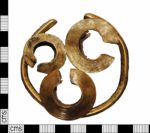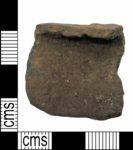 Metal detectorists in Cumbria have discovered a small Bronze Age hoard that is the first of its kind found in the county. The hoard was cached in a hole in the bedrock covered by stones. The group, small in size but large in historical significance, consists of one gold bracelet, three gold penannular lock-rings and one copper alloy cauldron fragment, all dating to the late Bronze Age. Three of the four jewelry pieces (the bracelet and two lock rings) have stains that may be corrosion or the residue of an organic material buried with them. The stains could also have been caused by something in the soil itself at the time of deposition, although if that were the case it seems like the other objects would have the same kind of staining.
Metal detectorists in Cumbria have discovered a small Bronze Age hoard that is the first of its kind found in the county. The hoard was cached in a hole in the bedrock covered by stones. The group, small in size but large in historical significance, consists of one gold bracelet, three gold penannular lock-rings and one copper alloy cauldron fragment, all dating to the late Bronze Age. Three of the four jewelry pieces (the bracelet and two lock rings) have stains that may be corrosion or the residue of an organic material buried with them. The stains could also have been caused by something in the soil itself at the time of deposition, although if that were the case it seems like the other objects would have the same kind of staining.
 The lock rings are made from sheets of gold curved into circular shapes. They are bound to an outer circle with gold wire and have been delicately incised with concentric rings vaguely reminiscent of the tracks on old wax or vinyl records. Two of the lock rings are almost identical in size — only 1 cm difference in width and .1 gram in weight — and while the third is smaller than the other two, the craftsmanship is so similar experts believe they were created if not by the same hand, then by the same workshop.
The lock rings are made from sheets of gold curved into circular shapes. They are bound to an outer circle with gold wire and have been delicately incised with concentric rings vaguely reminiscent of the tracks on old wax or vinyl records. Two of the lock rings are almost identical in size — only 1 cm difference in width and .1 gram in weight — and while the third is smaller than the other two, the craftsmanship is so similar experts believe they were created if not by the same hand, then by the same workshop.
The lock rings, meanwhile, are very similar to an example from Portfield Camp, near Whalley, Lancashire.
The purpose of this latter kind of artefact is much debated, through – as they are normally found in pairs, it has been suggested that they may have been a form of high-status personal ornament peculiar to the late Bronze Age (c.1000-800 BC), possibly earrings or some kind of hair decoration.
These newly discovered examples, decorated with concentric rings and bound with gold wire, are unusual for being a group of three.
 The gold penannular bracelet, with its undecorated design, flat, circular terminals and uneven curvature has features in common with an example now in the British Museum which was unearthed at Beachy Head, East Sussex, in the 19th century and is now in the British Museum. The bracelet and three lock rings are all a strong yellow color, an indication that the gold has copper added to the alloy.
The gold penannular bracelet, with its undecorated design, flat, circular terminals and uneven curvature has features in common with an example now in the British Museum which was unearthed at Beachy Head, East Sussex, in the 19th century and is now in the British Museum. The bracelet and three lock rings are all a strong yellow color, an indication that the gold has copper added to the alloy.
 The find spot — isolated, out-of-reach, high places located near notable features like hillforts and stone circles — is very much in keeping with past Bronze Age lock ring finds. The cauldron fragment is unusual for a lock ring cache. It may have been a previous deposition, but experts don’t think so because it was so found so close to the other pieces that it seems they were all buried together.
The find spot — isolated, out-of-reach, high places located near notable features like hillforts and stone circles — is very much in keeping with past Bronze Age lock ring finds. The cauldron fragment is unusual for a lock ring cache. It may have been a previous deposition, but experts don’t think so because it was so found so close to the other pieces that it seems they were all buried together.
The findspot lies in an isolated high place on a prominent ridge that seems to have been an area visited throughout later prehistory. It is situated just below a possible Iron Age hillfort and close to a number of other prehistoric settlement sites, as well as a concentric stone circle. The presence of roughed-out stone axes found nearby hints at the site lying on one of the major transmission routes south for the Langdale axe factories during the Neolithic period, while socketed bronze axes that were also found nearby, probably from a smith’s hoard, point to the area’s importance during the Bronze Age.
‘The enclosed platform, sometimes described as a hillfort, has no evidence of buildings or habitation,’ said Stuart [Noon, Finds Liaison Officer for Lancashire and Cumbria]. ‘It appears that the site may have been of ritual importance, a place where offerings could be placed or buried in the ground or even inserted into the limestone outcrops, and which, it could be speculated, may have hosted gatherings and celebrations.’
The ‘bracelet’ and the three ‘rings’ are seemingly separate pieces, but could the ‘bracelet’ in fact be one of several ingots, i.e. raw material of which the rings were made ?
First, I had wondered if the whole piece, i.e. the one with the three ‘lock rings’ -obviously in three different sizes- had been cast in a single process in order to solder or weld the rings onto somewhere else.
A lot of Bronze Age sheet metal was ‘simply’, but not simple at all, wrought.
In my lifetime the study of the Olden Days has been advanced wonderfully in varied ways – carbon dating, dendrochronology, pollen studies, metal detecting, civil engineering projects, ancient DNA, decryption of ancient languages (I still reread Chadwick’s Linear B book from time to time), the passing of intelligent legislation, and too many others to list. It’s a Golden Age.
“a hole in the bedrock”: Cumbria is well provided with bedrock. Have you been there? When it’s not being beautiful, it’s being grim.
Okay, I’ll bite. What (in an ancient context) is a “lock ring”? When I Google it, I get bicycle parts.
Fascinating! I take it we’re not allowed to know where the find spot is?
@John, all there really is to that term is not ‘in an ancient context’.
Those rings just look like some lock rings do, indeed, on bikes and elsewhere: It might pay off to have a lock ring e.g. in between a steel screw head and whatever softer material it is screwed into (wood, aluminum etc.).
Of course, lock rings made of gold or copper wont do the trick at all.
Since the “lock rings” look rather like auto tires with a bite take out of them I suspect that they may have covered some sort of organic core such as wood which is now decayed. Gold sheet like this without some sort of internal support would be pretty fragile,
It would be easy to slip such a split ring into one’s hair.